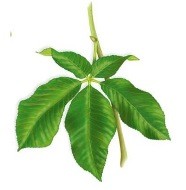Identify the leaf pictured as a compound or simple leaf. Explain what observations were used to make your decision. 
What will be an ideal response?
Answers may vary. The leaf is a compound leaf composed of five leaflets. Note the one axillary bud in the upper angle between the stem and the leaf. If this were a branch with simple leaves, a terminal bud would be found at the tip of the branch. Note the absence of a terminal bud.
You might also like to view...
Seagrasses are not true grasses
Indicate whether the statement is true or false
Skeletal muscles are connected to bones by cords of connective tissue called
a. muscle fibers. b. sarcomeres. c. tendons. d. ligaments. e. myofibrils.
Batrachochytrium dendrobatidis infects the skin of amphibians and leads to their death by blocking ________ ________.
Fill in the blank(s) with the appropriate word(s).
Which one of the following statements about transport of nutrients in phloem is correct?
A) Solute particles are actively transported from phloem at the source. B) Companion cells control the rate and direction of movement of phloem sap. C) Differences in osmotic concentration at the source and sink cause a hydrostatic pressure gradient to be formed. D) A sink is the part of a plant where a particular solute is produced.